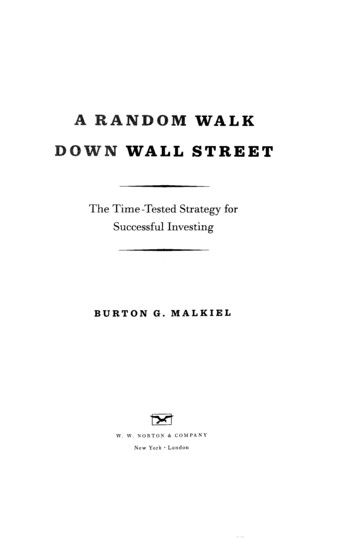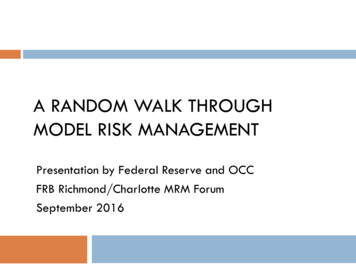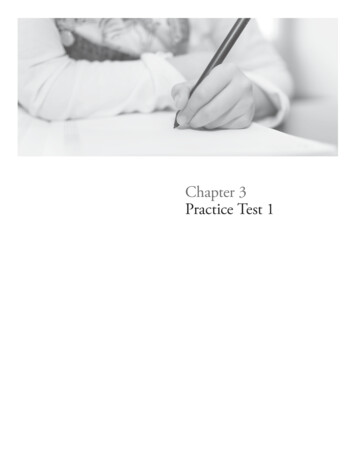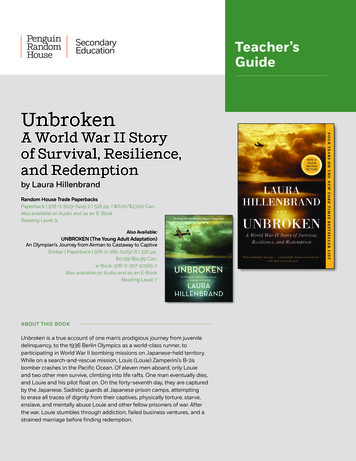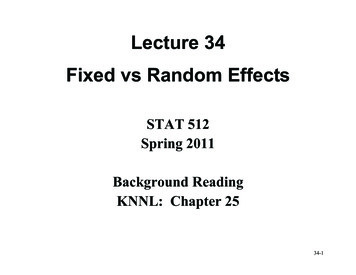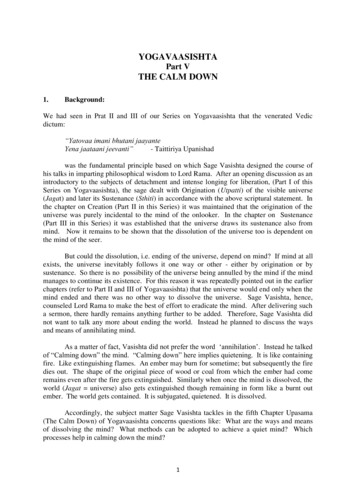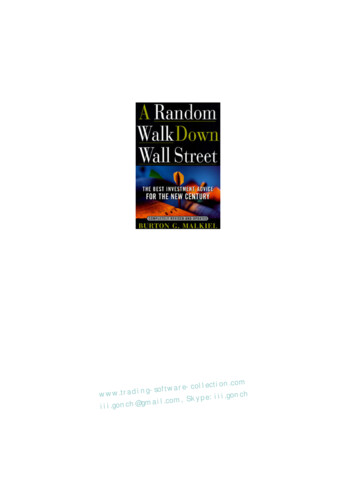
Transcription
h:epykS,mmail.coiii.gonch@gfile:///E nlReader.dll@BookID 32673&FileName Cover.html [10/7/2007 12:41:52 AM]
DocumentPage 3A Random Walk Down Wall StreetIncluding A Life-Cycle Guide To Personal InvestingBurton G. MalkielChemical Bank Chairman'sProfessor of EconomicsAt Princeton nch:epykS,mmail.coiii.gonch@gfile:///E 814/nlReader.dll@BookID 32673&FileName 3.html [10/7/2007 12:41:53 AM]
DocumentPage 4Copyright 1999, 1996, 1990, 1985, 1981, 1975,1973by W. W. Norton & Company, Inc.All rights reservedPrinted in the United States of AmericaThe text of this book is composed in Zapf Elliptical with the display set inBerling.Desktop composition by Justine Burkat TrubeyManufacturing by the Haddon Craftsmen, Inc.Library of Congress Cataloging-in-Publication DataMalkiel, Burton G.A random walk down Wall Street : including a life-cycle guideto personal investing / Burton G. Malkiel.p. cm.Rev. ed. of: a random walk down Wall Street. c1996.Includes bibliographical references and index.ISBN 0-393-04781-41. Investments. 2. Stocks. 3. Random walks (Mathematics)I. Malkiel, Burton G. Random walk down Wall Street. II. Title.HG4521 .M284 1999332.6 dc21 98-50671CIPW. W. Norton & Company, Inc., 500 Fifth Avenue, New York, N.Y.10110http://www.wwnorton.comW. W. Norton & Company Ltd., 10 Coptic Street, London WC1A gonch:epykS,mmail.coiii.gonch@gfile:///E 814/nlReader.dll@BookID 32673&FileName 4.html [10/7/2007 12:41:53 AM]
DocumentPage 5To pykS,mmail.coiii.gonch@gfile:///E 814/nlReader.dll@BookID 32673&FileName 5.html [10/7/2007 12:41:54 AM]
DocumentPage 7CONTENTSPreface13Acknowledgments from EarlierEditions17Part OneStocks and Their Value231. Firm Foundations and Castles in theAirWhat Is a RandomWalk?24Investing as a Way of LifeToday26Investing inTheory28The Firm-FoundationTheory29The Castle-in-the-Air Theory31How the Random Walk Is to BeConducted332. The Madness ofCrowds35on.comcollectiThe Tulip-BulberawtfosgCrazewww.tradin: iii.gonch, Skypeil.comamg@hcnoiii.gfile:///E Reader.dll@BookID 32673&FileName 7.html (1 of 3) [10/7/2007 12:41:54 AM]36
DocumentThe South SeaBubble39The Florida Real EstateCraze45Wall Street Lays anEgg46AnAfterword533. Stock Valuation from the Sixties through theNineties55The Sanity ofInstitutions55The SoaringSixties57The New "New Era": The Growth-Stock/New-IssueCraze57Synergy Generates Energy: The ConglomerateBoom61Performance Comes to the Market: The Bubble in ConceptStocks69The SourSeventies73The NiftyFiftyThe niii.gonch:epykS,mmail.coiii.gonch@gfile:///E Reader.dll@BookID 32673&FileName 7.html (2 of 3) [10/7/2007 12:41:54 AM]76
DocumentThe Triumphant Return of NewIssues76Concepts Conquer Again: The radiniii.gonch:epykS,mmail.coiii.gonch@gfile:///E Reader.dll@BookID 32673&FileName 7.html (3 of 3) [10/7/2007 12:41:54 AM]
DocumentPage 8The Chinese Romance with the Lycoris Plant80Some Other Bubbles of the1980s81What Does It AllMean?85The NervyNineties85The Japanese Yen for Land andStocks85The Internet Craze of the Late1990s90A FinalWord944. The Firm-Foundation Theory of StockPrices95The "Fundamental" Determinants of StockPrices96Two ImportantCaveats103Testing theRules106One MoreCaveat108tion.comcollecerWhat's Left of the FirmawtfosdingFoundation? www.trae: iii.gonch, Skypil.comamg@hcnoiii.gfile:///E Reader.dll@BookID 32673&FileName 8.html (1 of 3) [10/7/2007 12:41:55 AM]111
DocumentPart TwoHow the Pros Play the Biggest Game in Town5. Technical and FundamentalAnalysis117Technical versus FundamentalAnalysis118What Can Charts TellYou?119The Rationale for the ChartingMethod124Why Might Charting Fail toWork?126From Chartist toTechnician127The Technique of FundamentalAnalysis128Why Might Fundamental Analysis Fail toWork?132Using Fundamental and Technical AnalysisTogether1346. Technical Analysis and the Random-WalkTheoryHoles in Their Shoes and Ambiguity in i.gonch:epykS,mmail.coiii.gonch@gIs There Momentum in the StockMarket?file:///E Reader.dll@BookID 32673&FileName 8.html (2 of 3) [10/7/2007 12:41:55 AM]138138140
DocumentJust What Exactly Is a RandomWalk?142Some More Elaborate TechnicalSystems145The FilterSystem146The DowTheory146The ading ChartPatterns148Randomness Is Hard toAccept149A Gaggle of Other Technical Theories to Help You ch:epykS,mmail.coiii.gonch@gfile:///E Reader.dll@BookID 32673&FileName 8.html (3 of 3) [10/7/2007 12:41:55 AM]150
DocumentPage 9The Hemline Indicator151The Super Bowl Indicator153The Odd-Lot Theory153A Few More Systems155Technical Market Gurus155Why Are Technicians Still Hired?159Appraising the Counterattack160Implications for Investors1637. How Good Is Fundamental Analysis?165The Views from Wall Street and Academia166Are Security Analysts Fundamentally Clairvoyant?166Why the Crystal Ball Is Clouded1701. The Influence of Random Events1712. The Creation of Dubious Reported Earnings through "Creative"Accounting Procedures1723. The Basic Incompetence of Many of the Analysts Themselves1744. The Loss of the Best Analysts to the Sales Desk or to ww.traiii.gonch:epykS,mmail.coiii.gonch@gfile:///E Reader.dll@BookID 32673&FileName 9.html (1 of 2) [10/7/2007 12:41:56 AM]
DocumentDo Security Analysts Pick Winners? The Performance of the Mutual Funds178Can Any Fundamental System Pick Winners?186The Verdict on Market Timing187The Semi-strong and Strong Forms of the Random-Walk Theory190The Middle of the Road: A PersonalViewpoint193Part ThreeThe New Investment Technology8. A New Walking Shoe: Modern Portfolio Theory199The Role of Risk200Defining Risk: The Dispersion of Returns201Exhibit201Expected Return and Variance: Measures of Reward and Risk201Documenting Risk: A Long-Run Study204Reducing Risk: Modern Portfolio Theory (MPT)206Diversification in Practice2119. Reaping Reward by Increasing RiskBeta and Systematic ykS,mmail.coiii.gonch@gfile:///E Reader.dll@BookID 32673&FileName 9.html (2 of 2) [10/7/2007 12:41:56 AM]220221
DocumentPage 10The Capital-Asset Pricing Model (CAPM)224Let's Look at theRecord229An Appraisal of theEvidence232The Quant Quest for Better Measures of Risk: Arbitrage PricingTheoryA SummingUp23423710. The Assault on the Random-Walk Theory: Is the Market Predictable afterAll?Predictable Patterns in the Behavior of StockPrices2402421. Stocks Do Sometimes Get on One-Way Streets2432. But Eventually Stock Prices Do Change Direction and HenceStockholder Returns Tend to Reverse Themselves2443. Stocks Are Subject to Seasonal Moodiness, Especially at the Beginningof the Year and the End of the Week247Predictable Relationships between Certain "Fundamental" Variables and FutureStock Prices2491. Smaller Is Often Better2492. Stocks with Low Price-Earnings Multiples Outperform Those with ii.gonch:epykS,mmail.coiii.gonch@gfile:///E eader.dll@BookID 32673&FileName 10.html (1 of 3) [10/7/2007 12:41:56 AM]
Document3. Stocks that Sell at Low Multiples of Their Book Values Tend to ProduceHigher Subsequent Returns2534. Higher Initial Dividends and Lower Price-Earnings Multiples HaveMeant Higher Subsequent Returns2545. The "Dogs of the Dow" Strategy258And the WinnerIs . . .The Performance of pendix: The Market Crash of October1987270Part FourA Practical Guide for Random Walkers and Other Investors11. A Fitness Manual for RandomWalkers277Exercise 1: Cover Thyself withProtection278Exercise 2: Know Your InvestmentObjectives281Exercise 3: Dodge Uncle Sam Whenever YouCan289Pension Plans :epykS,mmail.coiii.gonch@gfile:///E eader.dll@BookID 32673&FileName 10.html (2 of 3) [10/7/2007 12:41:56 AM]289
gfile:///E eader.dll@BookID 32673&FileName 10.html (3 of 3) [10/7/2007 12:41:56 AM]
DocumentPage 11Tax-DeferredAnnuities294Exercise 4: Be Competitive; Let the Yield on Your Cash Reserve Keep Pacewith Inflation295Money-Market Mutual Funds295Money-Market Deposit Accounts297Bank Certificates299Tax-Exempt Money-Market Funds300301Exercise 5: Investigate a Promenade through Bond CountryZero-Coupon Bonds Can Generate Large Future Returns302No-Load Bond Funds Are Appropriate Vehicles for Individual Investors303Tax-Exempt Bonds Are Useful for High-Bracket Investors305Hot TIPS: Inflation Indexed Bonds307Should You Be a Bond-Market Junkie?309Exercise 6: Begin Your Walk at Your Own Home; Renting Leads to FlabbyInvestment Muscles310Exercise 7: Beef Up with Real Estate Investment Trusts313Exercise 8: Tiptoe through the Investment Fields of Gold and Collectibles318ction.comlle Some ArecoRandomeraExercise 9: Remember that CommissionCostsAreNotwtfosghwww.tradinCheaper than Otherspe: iii.gonc, Skyil.comamg@hcnoiii.gfile:///E eader.dll@BookID 32673&FileName 11.html (1 of 2) [10/7/2007 12:41:57 AM]322
DocumentExercise 10: Diversify Your Investment Steps324A Final Checkup32412. Handicapping the Financial Race: A Primer in Understanding and ProjectingReturns from Stocks and Bonds326What Determines the Returns from Stocks and Bonds?326Three Eras of Financial Market Returns331Era I: The Age of Comfort333Era II: The Age of Angst334Era III: The Age of Exuberance340The Age of the Millennium342Appendix: Projecting Returns for Individual Stocks34713. A Life-Cycle Guide to Investing351Four Asset Allocation Principles3521. Risk and Reward Are Related3522. Your Actual Risk in Stock and Bond Investing Depends on the Length ofTime You Hold Your .gonch:epykS,mmail.coiii.gonch@gfile:///E eader.dll@BookID 32673&FileName 11.html (2 of 2) [10/7/2007 12:41:57 AM]
DocumentPage 123. Dollar-Cost Averaging Can Reduce the Risks of Investing in Stocks andBonds3564. The Risks You Can Afford to Take Depend on Your Total FinancialSituation360Three Guidelines to Tailoring a Life-Cycle InvestmentPlan3621. Specific Needs Require Dedicated SpecificAssets3632. Recognize Your Tolerance for Risk3633. Persistent Savings in Regular Amounts, No Matter How Small, Pays Off367The Life-Cycle Investment Guide14. Three Giant Steps Down Wall Street368372The No-Brainer Step: Investing in Index Funds373The Index Fund Solution: A Summary375A Broader Definition ofIndexing378A Specific Index FundPortfolio382The Tax-Managed IndexFund383The Do-It-Yourself Step: Potentially Useful iniii.gonch:epykS,mmail.coiii.gonch@gfile:///E eader.dll@BookID 32673&FileName 12.html (1 of 2) [10/7/2007 12:41:58 AM]386
DocumentThe Substitute-Player Step: Hiring a Professional Wall-Street Walker391Risk Level394Unrealized Gains394Expense Ratios395The Morningstar Mutual-Fund Information Service395A Primer on Mutual-Fund Costs398Loading Fees399Expense Charges399Comparing Mutual-Fund Costs400The Malkiel Step401A Paradox405Some Last Reflections on Our Walk406A Random Walker's Address Book and Reference Guide to Mutual file:///E eader.dll@BookID 32673&FileName 12.html (2 of 2) [10/7/2007 12:41:58 AM]
DocumentPage 13PREFACEIt has now been close to thirty years since I began writing the first edition of A Random Walk DownWall Street. The message of the original edition was a very simple one: Investors would be far better offbuying and holding an index fund than attempting to buy and sell individual securities or activelymanaged mutual funds. I boldly stated that buying and holding all the stocks in a broad, stock-marketaverage as index funds do was likely to outperform professionally managed funds whose high expensecharges and large trading costs detract substantially from investment returns.Now, some thirty years later, I believe even more strongly in that original thesis, and there's more than asix-figure gain to prove it. The chart on the following page makes the case with great simplicity. Itshows how an investor with 10,000 at the start of 1969 would have fared investing in a Standard &Poor's 500-Stock Index Fund. For comparison, the results are also plotted for a second investor whoinstead purchased shares in the average actively managed fund. The difference is dramatic. ThroughJune 30, 1998, the index investor was ahead by almost 140,000, with her original 10,000 increasingthirty-one-fold to 311,000. And the index returns were calculated after deducting the typical expenses(2/10 of 1 percent) charged for running an index pykS,mmail.coiii.gonch@gfile:///E 14/nlReader.dll@BookID 32673&FileName 13.html [10/7/2007 12:41:58 AM]
DocumentPage 14The Value of 10,000 Invested in 1969Why then a seventh edition of this book? If the basic message hasn't changed, what has? The answer isthat there have been enormous changes in the financial instruments available to the public. A bookmeant to provide a comprehensive investment guide for individual investors needs to be updated tocover the full range of investment products available. In addition, investors can benefit from a criticalanalysis of the wealth of new information provided by academic researchers and marketprofessionals made comprehensible in prose accessible to everyone with an interest in investing. Therehave been so many bewildering claims about the stock market that it's important to have a book that setsthe record straight.Over the past quarter century, we have become accustomed to accepting the rapid pace of technologicalchange in our physical environment. Innovations such as cellular and video telephones, cable television,compact discs, microwave ovens, laptop computers, the Internet, e-mail, and new medical advancesfrom organ transplants and laser surgery to nonsurgical methods of treating kidney stones andunclogging arteries have materially affected the way we live. Financial innovation over the same periodhas been equally rapid. In 1973, when kS,mmail.coiii.gonch@gfile:///E 14/nlReader.dll@BookID 32673&FileName 14.html [10/7/2007 12:41:58 AM]
DocumentPage 15first edition of this book appeared, we did not have money market funds, NOW accounts, ATMs, indexmutual funds, tax-exempt funds, emerging-market funds, floating-rate notes, inflation protectionsecurities, equity REITs, Roth IRAs, zerocoupon bonds, S&P index futures and options, and newtrading techniques such as ''portfolio insurance" and "program trading," just to mention a few of thechanges that have occurred in the financial environment. Much of the new material in this book hasbeen included to explain these financial innovations and to show how you as a consumer can benefitfrom them.This edition takes a hard look at the basic thesis of earlier editions of Random Walk that the marketprices stocks so efficiently that a blindfolded chimpanzee throwing darts at the Wall Street Journal canselect a portfolio that performs as well as those managed by the experts. Through the past thirty yearsthat thesis has held up remarkably well. More than two-thirds of professional portfolio managers havebeen outperformed by the unmanaged S&P 500-Stock Index. Nevertheless, a number of studies byacademics and practitioners, completed during the 1980s and 1990s, have cast doubts on the validity ofthe theory. And the stock market crash of October 1987 raised further questions concerning the vauntedefficiency of the market. This edition explains the recent controversy and reexamines the claim that it'spossible to "beat the market." I conclude that reports of the death of the efficient-market theory arevastly exaggerated. I will, however, review the evidence on a number of techniques of stock selectionthat are believed to tilt the odds of success in favor of the individual investor.The book remains fundamentally a readable investment guide for individual investors. As I havecounseled individuals and families about financial strategy, it has become increasingly clear to me thatone's capacity for risk bearing depends importantly upon one's age and ability to earn income from noninvestment sources. It is also the case that the risk involved in most investments decreases with thelength of time the investment can be held. For these reasons, optimal investment strategies must be agerelated. Chapter Thirteen, entitled "A Life-Cycle Guide to Investing," should prove very helpful topeople of all ages. This chapter alone is worth the cost of a high-priced appointment with a personalfinancial adviser.Finally, the facts and figures in the book have been nch:epykS,mmail.coiii.gonch@gfile:///E 14/nlReader.dll@BookID 32673&FileName 15.html [10/7/2007 12:41:59 AM]
DocumentPage 16revised and updated. I survey the stock and bond markets at the end of the twentieth century and presenta set of strategies that should successfully carry investors into the new millennium.My debts of gratitude to those mentioned in earlier editions continue. In addition, I must mention thenames of a number of people who were particularly helpful in making special contributions to theseventh edition. These include James Litvack, Gabrielle Napolitano, Abby Joseph Cohen, James Riepe,George Sauter, John Bogle, Leila Heckman, Will McIntosh, Keith Mullins, Jim Troyer, Andrew Engel,Mark Thompson, Steven Goldberg, Willy Spat, and David Twardock. Special thanks go to WalterLenhard and Andrew Clarke of The Vanguard Group of Investment Companies, who assembled muchof the financial data on investment returns used in this edition, and to Shane Antos and JonathanCurran, who provided indispensable and superb research assistance. Lugene Whitley madeextraordinary contributions in transforming various illegible drafts and dictating tapes into readabletext. Phyllis Durepos also provided valuable typing assistance. Ed Parsons and Mark Henderson of W.W. Norton provided indispensable assistance in bringing this edition to publication. Patricia Taylorcontinued her association with the project and made extemely valuable editorial contributions to theseventh edition.My wife, Nancy Weiss Malkiel, made by far the most important contributions to the successfulcompletion of the past three editions. In addition to providing the most loving encouragement andsupport, she read carefully through various drafts of the manuscript and made innumerable suggestionsthat clarified and vastly improved the writing. She even corrected several errors that had eluded me anda variety of proofreaders and editors over the first four editions. Most important, she has broughtincredible joy to my life. No one more deserved the dedication of a book than she.BURTON G. MALKIELPRINCETONUNIVERSITYOCTOBER ykS,mmail.coiii.gonch@gfile:///E 14/nlReader.dll@BookID 32673&FileName 16.html [10/7/2007 12:42:00 AM]
DocumentPage 17ACKNOWLEDGMENTS FROM EARLIER EDITIONSMy debts of gratitude to people and institutions who have helped me with the first edition of this bookare enormous in both number and degree. My academic colleagues and friends in the financialcommunity who have contributed to various drafts of chapters are too numerous to mention. I mustacknowledge explicitly, however, the many who have read through the entire manuscript and offeredextremely valuable suggestions and criticisms. These include Peter Asch, Leo Bailey, Jeffrey Balash,William Baumol, G. Gordon Biggar, Jr., Lester Chandler, Barry Feldman, William Grant, Sol Malkiel,Richard Quandt, Michael Rothschild, H. Barton Thomas, and Robert Zenowich. It is particularlyappropriate that I emphasize the usual caveat that the above-named individuals are blameless for anyerrors of fact or judgment in these pages. Many have warned me patiently and repeatedly about themadness of my heresies, and the above list includes several who disagree sharply with my position.Many research assistants have labored long in compiling information for this book. Especially usefulcontributions were made by Barry Feldman, Paul Messaris, Barry Schwartz, Greg Smolarek, RaySoldavin, and Elizabeth Woods. Helen pykS,mmail.coiii.gonch@gfile:///E 14/nlReader.dll@BookID 32673&FileName 17.html [10/7/2007 12:42:00 AM]
DocumentPage 18and Phyllis Durepos not only faithfully and accurately typed several drafts of the manuscript, but alsooffered extremely valuable research assistance as well. Elvira Giaimo provided most helpful computerprogramming. Many of the supporting studies for this book were conducted at Princeton's FinancialResearch Center.A vital contribution was made by Patricia Taylor, a professional writer and editor. She read through twocomplete drafts of the book and made innumerable contributions to the style, organization, and contentof the manuscript. She deserves much of the credit for whatever lucid writing can be found in thesepages.I am also grateful to Arthur Lipper Corporation for permission to use their mutual fund rankings,Wiesenberger Investment Services for the use of their data in many of my tables, Moody's InvestorsService for permission to reproduce several of their stock charts, Consumers Union for their estimatesof life insurance costs, College Retirement Equities Fund for making available to me James Farrell'sperformance studies, and Smith, Barney & Co., Inc. for allowing me the run of their investment library.My association with W. W. Norton & Company has been an extremely pleasant one, and I amparticularly grateful to my editor, Starling Lawrence, for his invaluable help.Finally, the contribution of Judith Malkiel was of inestimable importance. She painstakingly editedevery page of the manuscript and was helpful in every phase of this undertaking. This acknowledgmentof my debt to her is the largest understatement of all.In later editions I have been fortunate to have been able to continue to count on the help of many ofthose who assisted in the earlier editions. In addition, I want to express my gratitude for the absolutelyessential assistance of John Bogle, Kelly Mingone, Ian MacKinnon, James Norris, and MelissaMcGinnis of The Vanguard Group of Investment Companies; Donald Peters of T. Rowe Price; EdwardMathias of The Carlyle Group; Howard Baker of the American Stock Exchange; Frank Wisneski andEd Owens of Wellington Management Company; H. Bradlee Perry of David L. Babson & Co.; GeorgePutnam of Putnam Funds; George S. Johnston of Scudder, Stevens & epykS,mmail.coiii.gonch@gfile:///E 14/nlReader.dll@BookID 32673&FileName 18.html [10/7/2007 12:42:00 AM]
DocumentPage 19Roger Ford of Prudential Insurance; Robert Salomon, Jr., of Salomon Brothers; William Helman andJames Stoeffel of Smith Barney; and George Smith of Baker, Fentress & Company. I also acknowledgethe helpful assistance of Douglas Daniels, Shang Song, and Robert Ibbotson. Steve Feinstein, WilliamMinicozzi, Ethan Hugo, David Banyard, and Deborah Jenkens. Yexiao Xu provided invaluable researchassistance, and Linda Wheeler offered exceedingly skillful editorial assistance. Superb typing supportwas provided by Barbara Johnson, Barbara Mains, Kay Kerr, Pia Ellen, Claire Cabelus, and especiallyPhyllis Durepos. Donald Lamm, Robert Kehoe, and Deborah Makay continued to make my associationwith W. W. Norton a most pleasant one. Joan Ryan and Claire Bien were extremely helpful in preparingnew and updated charts. Michele Petersen also assisted in many ways. Finally, Rugby was particularlycooperative in agreeing to chew shoes and pillows instead of this manuscript. The first edition ofRandom Walk was dedicated to Jonathan, without whom the original manuscript would have beencompleted a year earlier. Because of Rugby's essential contributions, she was added to the dedication ofthe fourth h:epykS,mmail.coiii.gonch@gfile:///E 14/nlReader.dll@BookID 32673&FileName 19.html [10/7/2007 12:42:01 AM]
DocumentPage 21PART ONESTOCKS AND THEIR pykS,mmail.coiii.gonch@gfile:///E 14/nlReader.dll@BookID 32673&FileName 21.html [10/7/2007 12:42:01 AM]
DocumentPage 231Firm Foundations and Castles in the AirWhat is a cynic? A man who knows the price of everything, and the value ofnothing.Oscar Wilde, Lady Windermere's FanIn this book I will take you on a random walk down Wall Street, providing a guided tour of the complexworld of finance and practical advice on investment opportunities and strategies. Many people say thatthe individual investor has scarcely a chance today against Wall Street's professionals. They point totechniques the pros use such as "program trading," "portfolio insurance," and investment strategiesusing complex derivative instruments, and they read news reports of mammoth takeovers and the highlyprofitable (and sometimes illegal) activities of well-financed arbitrageurs. This complexity suggests thatthere is no longer any room for the individual investor in today's institutionalized markets. Nothingcould be further from the truth. You can do as well as the experts perhaps even better. As I'll point outlater, it was the steady investors who kept their heads when the stock market tanked in October 1987,and then saw the value of their holdings eventually recover and continue to produce attractive returns.And many of the pros lost their shirts during the 1990s using derivative strategies they failed tounderstand.This book is a succinct guide for the individual investor. S,mmail.coiii.gonch@gfile:///E 14/nlReader.dll@BookID 32673&FileName 23.html [10/7/2007 12:42:01 AM]
DocumentPage 24covers everything from insurance to income taxes. It gives advice on shopping for the best mortgageand planning an Individual Retirement Account. It tells you how to buy life insurance and how to avoidgetting ripped off by banks and brokers. It will even tell you what to do about gold and diamonds. Butprimarily it is a book about common stocks an investment medium that not only has provided generouslong-run returns in the past but also appears to represent good possibilities for the years ahead. The lifecycle investment guide described in Part Four gives individuals of all age groups specific portfoliorecommendations for meeting their financial goals.What Is a Random Walk?A random walk is one in which future steps or directions cannot be predicted on the basis of pastactions. When the term is applied to the stock market, it means that short-run changes in stock pricescannot be predicted. Investment advisory services, earnings predictions, and complicated chart patternsare useless. On Wall Street, the term "random walk" is an obscenity. It is an epithet coined by theacademic world and hurled insultingly at the professional soothsayers. Taken to its logical extreme, itmeans that a blindfolded monkey throwing darts at a newspaper's financial pages could select aportfolio that would do just as well as one carefully selected by the experts.Now, financial analysts in pin-striped suits do not like being compared with bare-assed apes. Theyretort that academics are so immersed in equations and Greek symbols (to say nothing of stuffy prose)that they couldn't tell a bull from a bear, even in a china shop. Market professionals arm themselvesagainst the academic onslaught with one of two techniques, called fundamental analysis and technicalanalysis, which we will examine in Part Two. Academics parry these tactics by obfuscating the randomwalk theory with three versions (the "weak," the "semi-strong," and the "strong") and by creating theirown theory, called the new investment technology. This last includes a concept called beta, and I intendto trample on that a bit. By the 1990s, even some ch:epykS,mmail.coiii.gonch@gfile:///E /Unpo
A random walk down Wall Street : including a life-cycle guide to personal investing / Burton G. Malkiel. p. cm. Rev. ed. of: a random walk down Wall Street. c1996. Includes bibliographical references and index. ISBN 0-393-04781-4 1. Investments. 2. Stocks. 3. Random walks (Mathematics) I. Malkiel, Burton G. Random walk down Wall Street. II. Title.File Size: 2MB

